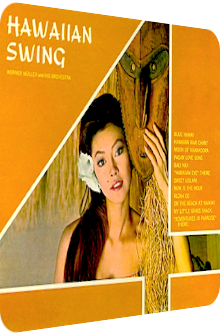
Werner Müller
Hawaiian Swing
1962
Having dreamt about becoming a world-famous lecturer in African Studies and adventurous traveller around the globe, German multi-talent Werner Müller (1920–1998) instead became a famous composer who scored many ephemeral films in the 1950's, released many kitschy and highly embarrassing Tango-focused records… and the occasional truly magnificent Exotica record, of which Hawaiian Swing, released at the end of 1962 on Decca Records and hence celebrating its 50th anniversary in 2012, undoubtedly takes the cake, with the excitingly Far Eastern Holiday In Japan (which he recorded under the pseudonym of Ricardo Santos in 1958) and the Oriental-Asian hybrid East Of India (1963) on the runner-up slots.
Its title is triple A, in this case referring to an admittedly audacious affront, as the frame or skeleton of twelve Hapa Haole and traditional Hawaiian Folk songs is transferred into the swinging 60's and garnished with – possibly one too many – Hammond and Fender organs, Hollywood strings and horn eruptions. It's a matter of taste. What works amazingly well, regardless of your viewpoint in terms of the above instruments or the bold advertisement of the Phase 4 audiophile recording technique as depicted by the big number on the front cover, are the additional devices Müller and his orchestra are using, ranging from sleek spy theme guitars over harmonicas to a marvelously carved out percussion section. The bold bongos, crunchy congas and dynamic djembes are omnipresent, killing off the last remaining doubts about linking this particular work to the Exotica genre.
The scope is rather large, for it's a symphonic record after all, but these drums and percussive instruments really add the intimacy of an Exotica quartet and marry it with the technicolor panoramas of Les Baxter and colleagues. There are several flaws and unacceptable stylistic decisions to be found on Hawaiian Swing, but once Werner Müller is on a roll, he delivers awesome renditions that enchant the listener to the maximum. Luckily, the successful material outnumbers the occasional duds by far, with more detailed explanations given below.
Blue Hawaii, now that's what I call a splendid opener on paper – although not everybody gets it right. Leo Robin's and Ralph Rainger's classic, however, is presented in a glaringly saccharine version here. Müller's German heritage is indeed noticeable in his way of conducting. The string sections are bathed in honey and boost the Sunday afternoon yearning, while clicking castanets and careful double bass backings are washed away by the syrup. After 45 seconds, the song gets better, with a short swinging interlude of mellow alto flutes that play in tandem with Milt Raskin-like accordions, the typical Hawaiian twangs of a ukulele and silkened brass bursts. Strangely enough, it is the usage of these very brass concoctions that let this record sound like a German Heimatmelodie concert. It's off-putting to me, but hugely exotic even in the given Exotica context. Since you won't hear anything – not even distantly – similar genre-related, let alone a like-minded interpretation of Blue Hawaii, this arrangement has its appeals, I'm sure. Especially the last 40 seconds are freed from their location, as the strings waft phantasmagorically and increase in size.
Speaking of freed: the following version of Hawaiian War Chant borrows heavily from the interpretation of Arthur Freed and Johnny Noble, putting the bongos and timpani in the foreground, with deliciously gleaming horn eruptions, Brazilian shakers, a convivial organ melody and dreamy steel guitar twangs. It's seldom that you hear this song with lots of trumpets, trombones and saxophones, so it's indeed a splendid interpretation with lots of quieter passages in which the ukuleles can shine until the next crescendo arises. Alfred Newman's and Frank Loesser's dreamy Moon Of Manakoora is presented in a Space-Age version here, with a field recording of chirping birds, ethereal (!) organ streams and warped violin strings with added ukuleles, smooth brass accents and curiously frosty plinks whose origin I cannot pinpoint, it's either a piano or another organ played in sky-high regions. It's a great version that is completed by a paradisiac flute and a field recording of ocean waves, birds and crickets.
Ploughing forward with a take on another one of Arthur Freed's compositions he co-wrote with Nacio Herb Brown, Pagan Love Song succeeds due to its hollow bongos, croaking guiros and a harmonica. Soon enough, this song moves into a slick mélange of a spy theme-like beer tent anthem! The cymbals and snare drums are never too far away, and carefully placed harp riffs as well as smoldering ukuleles and steel guitars provide the necessary link to Hawaii. After a rather abrupt end, it's time for the mandatory inclusion of Bali Ha'i by the successful duo Richard Rodgers and Oscar Hammerstein II. It's a surprisingly jazzy version with the typical spiraling double bass frame, atypical eruptions of organ-guitar couples, sneaky marimba droplets and droning timpani. Even the vibraphones are placed in-between the bongo beat and surf guitars. It's a boldly swinging version that injects many violin strings as well. A nice inclusion and a great counterpoint to the many dreamy downbeat versions out there.
The final piece of side A is a real treat, and I love it very much, as it is a rendition of the – then brand new – theme of the television crime series Hawaiian Eye. The theme was co-written by Mack David and Jerry Livingston, and I can only advise you to check out the utterly great Hawaiian Eye soundtrack, as conducted and arranged by Warren Barker. Müller's orchestra relies on Space-Age motifs yet again, with a wonky, indecisive route of both galactic guitar licks and solemn brass backings of the towering but cozy kind. Louder trumpets are put to the forefront and accompany the spacey setting by providing a earthen feeling. Once the horns erupt in neon colors after almost two minutes, the song reaches its definite climax, as the remaining sections are again dreamy and fragile. The melody is gorgeous, and only the male choir chanting Hawaiian Eeeeeye-ugh! is missing. A superb highlight of a classic TV theme.
Side B continues the good spirit and starts in an uplifting manner with Harry Owens' Sweet Leilani. It is an unexpectedly guitar-driven ditty with plucked steel guitars which are accompanied by Mexican trumpets that mimic the tonality of the guitar. Together with the gentle shakers, two percussive segues of bongos and clicking claves, and a final second-long marimba cascade, this is undoubtedly the boldest Hawaiian song without any strange curlicues à la Hammond organs, for instance. While Maewa Kailau's and Clement Scott's Now Is The Hour is the romantic downtempo song of the album, loaded with liquid harps, syrupy orchestra strings, tick-tocking bamboo rods, acoustic guitars, resplendent woodwinds and intersected ukuleles which altogether provide a good mood, the ancient classic Aloha Oe doesn't cause rolling eyes, since Müller presents a brass-heavy interpretation with gorgeous bongo beats, wafting double bass lines and the famous main melody on both the steel guitar and the horn ensemble. Clarinet tones make up the finishing touches of this swinging piece.
Henry Kailimai's On The Beach At Waikiki resides on the swing side, but boosts the tempo and spices it with pizzicato strings, surf guitars, vibraphone glints and too sugar-sweet strings which degrade the jocular qualities of this song quite a bit. Things get better, as Tommy Harrison's, Johnny Noble's and Bll Cogswell's My Little Grass Shack is the epitomizing-swinging shanty with sun-dried ukuleles and dark brass explosions, pumping drums, intertwined steel guitar twangs and dry surf guitar pluckings. The album closes with the theme of Adventures In Paradise. Dorcas Cochran's and Alfred Newman's anthem starts with torero fanfares which are later juxtaposed time and again to steel guitars, opulent Hollywood strings and bass flutes. Yet again are the strings honey-like, but the vibraphone sprinkles and bongos bust through the sugar hills and make this upbeat and overly kitschy version more tolerable.
Hawaiian Swing is a great orchestral album, with side A clearly succeeding in adducing the synergy of Hapa Haole and a big band setup. The symphonic strings are another plus, as are the percussive devices. Side B is much more swinging, and given the title and overarching concept of the album, this is no problem at all, it's just that I'm more fond of the tunes that break out of the formula at times. Many Exotica records are arbitrarily named, and one cannot link an album title to the majority of the given material; Werner Müller's album, however, is titled in a pitch-perfect way, as music, artwork and title form a wonderful unison. There's one particular quirkiness that might spoil the fun for some, and that is the distinctly German way of conducting the orchestra in general and the brass ensemble specifically.
Sometimes there are noticeable traces of German folk music to be found, an aspect that might be intriguing to, well, the targeted German audience, the whole population of Japan (okay, I'm exaggerating here) and many Exotica listeners who haven't encountered these characteristic traits in their favorite music genre before… or ever since. Given this fact, Müller created a mighty album, even though it's weirdly twisted, but that might be the actual source of fun. Highlights include the theme of Hawaiian Eye, the field recording-fueled Moon Of Manakoora and the heaviest swing version of Bali Ha'i you may encounter in your lifetime, as long as the big band incarnation of Mr. Ho's Orchestrotica keeps their hands off this classic. If you're longing for a Hawaiian song that stays as close to the original as possible in the given context, Sweet Leilani is a song to consider. The audiophile descriptions on the liner notes shouldn't scare you away, as this is no soulless record, but a vivid journey through Hawaii. Since the album is easily available on CD as well as on vinyl thanks to its status as a classic piece, Hawaiian Swing is an orchestral Exotica album with short quartet-like interludes and a stereotypical German attitude attached to a lot of its songs. Kaufen, meine Damen und Herren!
Exotica Review 124: Werner Muller – Hawaiian Swing (1962). Originally published on Sep. 22, 2012 at AmbientExotica.com.
